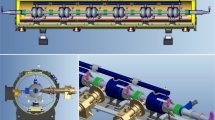Abstract
Background
The power loss of cavity high-order modes (HOMs) is a key issue in Circular Electron and Positron Collider (CEPC) RF system design. A large HOM power may cause a quench of SC cavity.
Purpose
The purpose of this article is to study the beam-induced HOM power for CEPC collider ring. The factors influencing the cavity HOM power are also investigated.
Methods
Starting with the beam filling patterns, the beam spectrums of different beam time structures are deduced. Then, the longitudinal impedance is simulated for CEPC 2-cell 650 MHz cavity. Finally, the cavity HOM power is calculated for CEPC CDR design.
Results
The cavity HOM power is 459 W for Higgs, 506 W for W and 1026 W for Z-pole. These values are smaller than the average values. There is no overlap between beam spectral lines and cavity HOM frequency.
Conclusion
The filling patterns of CEPC CDR Higgs, W and Z are safe. The dangerous filling patterns can be identified for CEPC Z-pole by scanning different parameters.
















Similar content being viewed by others
References
The CEPC-SPPC Study Group, CEPC Conceptual Design Report, IHEP-CEPC-CDR-2018-09, arXiv:1809.00285
Jie Gao, CEPC-SPPC accelerator status towards CDR. Int. J. Mod. Phys. A 32(34), 1746003 (2017)
J. Zhai et al., CEPC SRF system design and challenges, in Proceedings of SRF17, Lanzhou, China (2017). paperTUXAA01
D. Gong, J. Gao, J. Zhai et al., Cavity fundamental mode and beam interaction in CEPC main ring. Radiat. Detect. Technol. Methods 2, 17 (2018)
H. Padamsee, J. Knobloch, T. Hays, RF Superconductivity for Accelerators (Wiley, New York, 1998)
Sang-ho Kim et al., Higher-order-mode (HOM) power in elliptical superconducting cavities for intense pulsed proton accelerators. NIMA 492, 1 (2002)
I. Karpov et al., HOM power in FCC-EE cavities, CERN-ACC-NOTE-2018-0005 (2018)
H.J. Zheng et al., HOM simulations and damping scheme for CEPC Cavities, in Proceedings of IPAC2017 (2017)
Author information
Authors and Affiliations
Corresponding author
Additional information
This study was supported by National Key Programme for S&T Research and Development (Grant No. 2016YFA0400400), National Natural Science Foundation of China (No. 11575218), Key research Program of Frontier Science, CAS (Grant No. QYZDJ-SSW-SLH004).
Rights and permissions
About this article
Cite this article
Gong, D., Gao, J., Zheng, H. et al. Beam-induced HOM power in CEPC collider ring cavity. Radiat Detect Technol Methods 3, 18 (2019). https://doi.org/10.1007/s41605-019-0098-y
Received:
Revised:
Accepted:
Published:
DOI: https://doi.org/10.1007/s41605-019-0098-y




